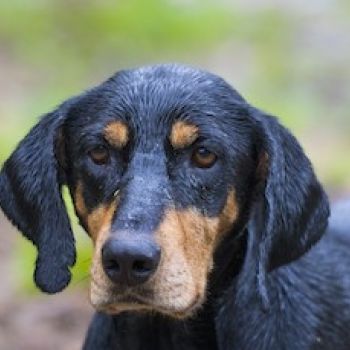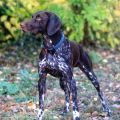The Hungarian Hound, also known as the Transylvanian Scent Hound, is a remarkable dog breed that originates from Hungary. This breed is highly regarded for its exceptional scenting abilities, making it an excellent choice for hunting and tracking purposes. With its striking appearance and impressive skills, the Hungarian Hound has gained popularity not only in its home country but also worldwide.
The history of the Hungarian Hound can be traced back several centuries. It is believed that this breed was developed by crossing various scent hounds brought to Hungary by the Magyars, a nomadic people who settled in the region during the 9th century. The breed's development was further influenced by the introduction of other European scent hounds, resulting in the creation of a versatile and efficient hunting dog.
According to the FCI (Fédération Cynologique Internationale) typology, the Hungarian Hound belongs to Group 6, Section 1.2, which includes medium-sized scent hounds. This group comprises breeds that excel in tracking and trailing scents, showcasing their exceptional olfactory capabilities. The Hungarian Hound is classified under the Scent Hounds category, which encompasses breeds specifically bred for their scenting abilities.
The Hungarian Hound is primarily used for hunting purposes, particularly in tracking and trailing game. Its keen sense of smell, coupled with its determination and endurance, make it an ideal companion for hunters. This breed is known for its ability to track wounded game over long distances, ensuring a successful hunt. Additionally, the Hungarian Hound's calm and friendly nature also makes it a suitable family pet, as it can adapt well to domestic life.
In terms of physical characteristics, the Hungarian Hound is a medium-sized dog with a well-muscled body. Males typically stand between 22 to 26 inches (56 to 66 cm) at the shoulder, while females are slightly smaller, ranging from 20 to 24 inches (51 to 61 cm). The breed's weight generally falls between 66 to 77 pounds (30 to 35 kg). Its coat is short, dense, and weather-resistant, providing protection during outdoor activities.
The Hungarian Hound has a distinctive appearance, with a noble and dignified expression. Its head is proportionate to its body, featuring a well-defined stop and a moderately long muzzle. The breed's eyes are medium-sized, dark, and expressive, while its ears are set high and hang close to the head. The Hungarian Hound's tail is thick at the base and tapers towards the end, reaching the hock when at rest.
In terms of temperament, the Hungarian Hound is known for its friendly and gentle nature. It is a loyal and affectionate breed, forming strong bonds with its family members. While it is generally good-natured, it may exhibit a certain level of independence, which is typical of scent hounds. Early socialization and consistent training are essential to ensure a well-behaved and obedient dog.
The Hungarian Hound has a relatively long lifespan compared to other breeds of similar size, typically ranging from 12 to 14 years. However, like any dog, it is important to provide proper care, including regular exercise, a balanced diet, and routine veterinary check-ups, to ensure its overall health and well-being.
Interesting facts about the Hungarian Hound include its exceptional sense of smell, which is considered one of the best among dog breeds. This breed's olfactory capabilities are so remarkable that it is often used in search and rescue operations, as well as in detecting illegal substances. Additionally, the Hungarian Hound is known for its endurance and stamina, allowing it to work tirelessly for extended periods.
In conclusion, the Hungarian Hound, or Transylvanian Scent Hound, is a remarkable breed with a rich history and exceptional scenting abilities. Its versatility as a hunting dog, coupled with its friendly and loyal nature, make it a popular choice among hunters and dog enthusiasts alike. With proper care and training, the Hungarian Hound can thrive as both a working dog and a beloved family pet.
The Hungarian Hound, also known as the Transylvanian Scent Hound, is a remarkable breed of dog that possesses a unique character and temperament. These dogs are known for their exceptional hunting abilities, loyalty, and intelligence. In this text, we will delve into the character of Hungarian Hounds, their behavior, and how to raise and train them effectively.
First and foremost, Hungarian Hounds are renowned for their strong hunting instincts. Bred for centuries to track and hunt game, they possess an exceptional sense of smell and an unwavering determination to follow a scent. This makes them excellent working dogs, particularly in tracking and trailing tasks. Their ability to focus on a scent for extended periods is truly remarkable.
Despite their hunting prowess, Hungarian Hounds are also known for their gentle and affectionate nature. They form strong bonds with their families and are incredibly loyal and protective. They thrive on human companionship and are happiest when they are included in family activities. These dogs are not suited for a solitary lifestyle and can become anxious or bored if left alone for long periods.
In terms of behavior, Hungarian Hounds are generally well-mannered and even-tempered. They are not typically aggressive or prone to excessive barking. However, it is important to note that they may exhibit some stubbornness, which can make training a bit challenging. Patience and consistency are key when it comes to training these dogs.
When raising a Hungarian Hound, it is crucial to provide them with plenty of mental and physical stimulation. Regular exercise is essential to keep them happy and healthy. Long walks, jogging, or engaging in activities such as agility or scent work can help satisfy their need for physical exertion. Mental stimulation can be achieved through puzzle toys, obedience training, or even participating in dog sports.
Socialization is another vital aspect of raising a Hungarian Hound. Early and ongoing socialization is necessary to ensure they grow up to be well-rounded and confident dogs. Exposing them to various people, animals, and environments from a young age will help them develop into friendly and adaptable companions.
Training a Hungarian Hound requires a firm and consistent approach. Positive reinforcement techniques, such as treats, praise, and rewards, work best with these dogs. They respond well to a gentle but firm hand, as harsh training methods can lead to fear or anxiety. Consistency in commands and expectations is crucial to prevent any confusion or stubbornness.
It is worth noting that Hungarian Hounds have a strong prey drive, which can make recall training challenging. It is essential to train them in a secure and controlled environment before allowing off-leash activities. Using long leads or training in enclosed spaces can help ensure their safety during training sessions.
In conclusion, Hungarian Hounds are remarkable dogs with a unique character. Their exceptional hunting abilities, loyalty, and affectionate nature make them wonderful companions for active individuals or families. With proper training, socialization, and plenty of mental and physical stimulation, these dogs can thrive and become well-rounded members of the family.
The Hungarian Hound, also known as the Transylvanian Scent Hound, is a beautiful and intelligent breed that requires specific care to ensure their well-being. Here are some tips on how to properly care for dogs of this breed, including what to do and what not to do.
First and foremost, the Hungarian Hound requires regular exercise to keep them physically and mentally stimulated. They are an active breed with a strong hunting instinct, so daily walks, runs, or play sessions in a secure area are essential. However, be cautious when letting them off-leash in an unfenced area, as their scenting abilities may lead them to wander off.
Proper nutrition is crucial for the overall health of the Hungarian Hound. Feed them a high-quality dog food that is appropriate for their age, size, and activity level. Consult with a veterinarian to determine the right amount of food and feeding schedule for your dog. Avoid overfeeding, as this breed is prone to obesity, which can lead to various health issues.
Regular grooming is necessary to keep the Hungarian Hound's coat in good condition. They have a short, dense, and weather-resistant coat that requires minimal maintenance. Brush their coat once or twice a week to remove loose hair and keep their skin healthy. Bathing should be done as needed, using a mild dog shampoo to avoid stripping the natural oils from their coat.
When it comes to training, the Hungarian Hound is a highly intelligent breed that responds well to positive reinforcement techniques. Start training early and be consistent, using rewards such as treats, praise, and playtime to motivate them. Socialization is also crucial, as they can be reserved with strangers. Expose them to various people, animals, and environments from a young age to ensure they grow up to be well-rounded dogs.
While caring for a Hungarian Hound, it's important to provide them with a safe and comfortable living environment. They are adaptable dogs that can live in both urban and rural settings, but they thrive in homes with access to a securely fenced yard where they can explore and play. Ensure that the yard is escape-proof, as they have a strong prey drive and may chase after small animals.
Avoid leaving the Hungarian Hound alone for extended periods, as they are a social breed that craves human companionship. They can become bored and develop destructive behaviors if left alone for too long. If you have to be away, provide them with interactive toys and consider hiring a dog walker or enrolling them in doggy daycare to keep them mentally stimulated and physically active.
Lastly, regular veterinary check-ups are essential to monitor the Hungarian Hound's health and catch any potential issues early on. Vaccinations, parasite prevention, dental care, and routine examinations should be part of their healthcare regimen.
In summary, caring for a Hungarian Hound requires regular exercise, proper nutrition, grooming, training, socialization, a safe living environment, and regular veterinary care. By following these tips and providing them with love and attention, you can ensure that your Hungarian Hound thrives and leads a happy and healthy life.
The Hungarian Hound, also known as the Transylvanian Scent Hound, is a magnificent breed that possesses a striking and unique coat color. These dogs exhibit a rich and deep shade of black, which is the most common color found in this breed. The black coloration of their coat is truly captivating and adds to their overall regal appearance.
The Hungarian Hound's black coat is glossy and lustrous, reflecting light in a way that enhances its beauty. It is a solid color that covers the entire body, from the tip of their nose to the end of their tail. The coat is dense and short, providing protection and insulation against various weather conditions.
One of the most fascinating aspects of the Hungarian Hound's black coat is its ability to accentuate their muscular build. The deep black color highlights the well-defined muscles, giving them a powerful and athletic appearance. This breed is known for its agility and endurance, and the black coat serves as a visual representation of their strength and athleticism.
In addition to the solid black color, some Hungarian Hounds may have small patches of white on their chest or toes. These white markings, although minimal, add a touch of elegance and contrast to their overall appearance. The white patches are often symmetrical and perfectly complement the black coat, creating a harmonious balance.
The Hungarian Hound's black coat not only contributes to their physical beauty but also serves a functional purpose. The dark coloration helps them blend seamlessly into their surroundings when they are on the hunt, making them excellent trackers and scent hounds. Their coat acts as a camouflage, allowing them to move stealthily and undetected through various terrains.
Furthermore, the black coat of the Hungarian Hound is relatively low maintenance. It does not require excessive grooming or frequent bathing, making it a practical choice for dog owners who prefer a breed with minimal coat care needs. Regular brushing to remove loose hair and occasional baths to keep their coat clean and shiny are usually sufficient to maintain their stunning appearance.
In conclusion, the Hungarian Hound's common color is a captivating and deep shade of black. This solid black coat, with occasional white markings, accentuates their muscular build and adds to their overall regal appearance. The black color not only enhances their physical beauty but also serves a functional purpose, allowing them to blend seamlessly into their surroundings. With their striking coat and athletic physique, the Hungarian Hound is truly a remarkable breed.
The Hungarian Hound, also known as the Transylvanian Scent Hound, is a robust and healthy breed with a relatively low incidence of genetic health issues. However, like all dogs, they are still susceptible to certain common diseases. In order to ensure the optimal health of your Hungarian Hound, it is essential to provide them with proper care, nutrition, exercise, and regular veterinary check-ups.
One of the most common health concerns in Hungarian Hounds is hip dysplasia. This is a hereditary condition where the hip joint does not develop properly, leading to pain, lameness, and arthritis. Regular exercise on soft surfaces and maintaining a healthy weight can help reduce the risk of hip dysplasia. Additionally, breeding dogs should be screened for this condition to minimize its occurrence in future generations.
Another health issue that can affect Hungarian Hounds is ear infections. Their long, droopy ears can trap moisture and debris, creating an ideal environment for bacteria and yeast to thrive. Regular ear cleaning with a veterinarian-recommended solution and keeping the ears dry can help prevent infections. It is important to check the ears regularly for any signs of redness, swelling, or discharge.
Like many large breeds, Hungarian Hounds can also be prone to bloat, a life-threatening condition where the stomach twists, trapping gas and food. Feeding them smaller, frequent meals and avoiding vigorous exercise immediately after meals can help reduce the risk of bloat. If you notice symptoms such as restlessness, unproductive vomiting, or a distended abdomen, seek immediate veterinary attention.
Maintaining good dental hygiene is crucial for the overall health of Hungarian Hounds. Regular brushing of their teeth, feeding them dental chews or treats, and scheduling professional dental cleanings can help prevent periodontal disease, which can lead to tooth loss and other health complications.
Proper nutrition is essential for the well-being of Hungarian Hounds. A balanced diet that meets their nutritional needs, including high-quality protein, healthy fats, and appropriate levels of carbohydrates, vitamins, and minerals, is crucial. Consult with your veterinarian to determine the best diet for your dog's age, activity level, and any specific health concerns.
Regular exercise is important for the physical and mental well-being of Hungarian Hounds. They are an active breed that requires daily walks, playtime, and mental stimulation. Engaging them in activities such as scent work, obedience training, or agility can help keep them physically fit and mentally stimulated.
Regular veterinary check-ups are essential for monitoring the overall health of Hungarian Hounds. Vaccinations, parasite prevention, and routine blood tests can help detect any underlying health issues early on. Your veterinarian may also recommend additional screenings or tests based on the specific needs of your dog.
In conclusion, Hungarian Hounds are generally a healthy breed with a few common health concerns. By providing them with proper care, nutrition, exercise, and regular veterinary check-ups, you can help ensure their optimal health and well-being. Remember, early detection and intervention are key to managing any potential health issues that may arise.
The Hungarian Hound, also known as the Transylvanian Scent Hound, is a breed of dog that originated in Hungary. These dogs are known for their exceptional hunting skills and their strong sense of smell. To ensure the health and well-being of your Hungarian Hound, it is crucial to provide them with a balanced and nutritious diet. Here is an extensive description of their nutrition, along with advice on how to feed them and what to avoid.
Feeding a Hungarian Hound requires a diet that meets their nutritional needs, supports their energy levels, and maintains their overall health. The key components of their diet should include high-quality protein, healthy fats, carbohydrates, vitamins, and minerals. Here are some guidelines to follow when feeding your Hungarian Hound:
1. High-quality protein: Protein is essential for muscle development and repair. Opt for lean sources of protein such as chicken, turkey, fish, or lamb. Avoid processed meats or those with excessive fat content.
2. Healthy fats: Healthy fats are a vital source of energy for Hungarian Hounds. Incorporate fats from sources like fish oil, flaxseed oil, or chicken fat. These fats also contribute to a healthy coat and skin.
3. Carbohydrates: Carbohydrates provide energy and should be included in moderate amounts. Opt for whole grains like brown rice, oats, or quinoa. Avoid grains that may cause allergies or digestive issues, such as wheat or corn.
4. Fruits and vegetables: These provide essential vitamins, minerals, and fiber. Include a variety of fruits and vegetables like carrots, sweet potatoes, blueberries, and spinach. Avoid toxic foods like grapes, raisins, onions, and garlic.
5. Portion control: Hungarian Hounds have a tendency to overeat, leading to weight gain. Divide their daily food into two or three meals and monitor their portion sizes based on their age, weight, and activity level.
6. Hydration: Always ensure your Hungarian Hound has access to fresh, clean water. Hydration is crucial for their overall health and digestion.
7. Avoid table scraps: While it may be tempting to share your food with your furry friend, it's important to avoid feeding them table scraps. Human food can be high in salt, sugar, and unhealthy fats, which can lead to obesity and other health issues.
8. Allergies and sensitivities: Hungarian Hounds may have specific food allergies or sensitivities. Monitor their reactions to certain foods and consult with a veterinarian if you suspect any allergies or intolerances.
9. Regular veterinary check-ups: Regular visits to the veterinarian are essential to monitor your Hungarian Hound's overall health and nutritional needs. They can provide specific advice based on your dog's individual requirements.
Remember, every Hungarian Hound is unique, and their nutritional needs may vary based on factors such as age, weight, activity level, and overall health. It's important to consult with a veterinarian or a professional canine nutritionist to create a personalized diet plan for your Hungarian Hound.
In conclusion, feeding your Hungarian Hound a balanced and nutritious diet is crucial for their overall health and well-being. Providing them with high-quality protein, healthy fats, carbohydrates, fruits, and vegetables will support their energy levels, maintain a healthy weight, and promote a shiny coat. Avoiding table scraps, monitoring portion sizes, and addressing any allergies or sensitivities will help ensure a long and healthy life for your beloved Hungarian Hound.







